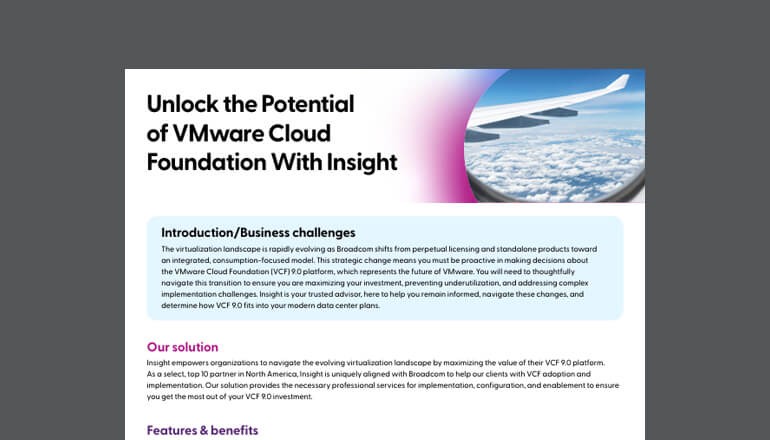Article Big Data and its Business Impacts: Implementation Examples to Learn From
There’s no doubt that you’ve heard about ‘big data’.
By Insight Editor / 6 Feb 2019 / Topics: Data center Intelligent edge

It’s a mission-critical capability that’s enabling businesses of all sizes to be leaner — and nimbler — in their decision-making process.
What is ‘Big Data?’
"Big data" refers to large volumes of structured and unstructured data that a business absorbs through various sources, such as customer-facing applications, websites, internet-of-things (IoT) devices, and others.
As a concept, big data is the leveraging of this vast reservoir created through the above sources to lower costs, get to market faster than the competition, and identify new opportunities for revenue growth.
Big Data for Business
To understand that last point, take a look at these real-world cases of big data implementation:
Oil & Gas
Using Microsoft Azure’s cloud services, Shell developed an analytics platform that leveraged artificial intelligence (AI) and data to forecast when any of its 3,000+ machine components could fail.
Equipped with this platform, Shell has been able to efficiently plan the procurement of new parts and avoid bottlenecks from a failing part or overspending on excess part replacement.
Logistics & Transport
Leveraging IoT, the logistics company Schneider National is collecting and interpreting data in the form of its trucks’ fuel usage, braking, and other metrics to optimize fuel usage and improve driver safety.
The goal is to maximize operational efficiency and lower risks on the road.
Financial Services
Big data is helping banks in a multitude of ways. By accessing multiple sides of an applicant’s real-world history, behavior, and needs, banks can accurately determine risk, identify upsells or expanded service offerings, and understand what might prompt a client to change banks.
As these examples show, big data is now instrumental in the way businesses become more competitive in their respective industries.
But to leverage big data, you must have the requisite infrastructure at hand. Otherwise, you’ll get bottlenecked in critical areas, such as data processing speed, capacity, and network speed.
What Goes into Developing Big Data Capabilities?
Strong Network Infrastructure & Hardware
To effectively develop big data capabilities, you will need the necessary network, data storage, and processing infrastructure.
In technical terms, you need these infrastructure elements for big data:
Data Layer
The foundation of your big data capabilities, the data layer is comprised of the servers that collect and store your data. When taking data from hundreds of thousands — or millions — of end-user or IoT sources, you will find that continually expanding your server infrastructure is a must.
Integration Layer
To analyze data, you need to collect it. The integration layer typically involves ingestion tools for Extract, Transform, and Load (ETL). Technologies include Stich, Blendo and Kafka. These ETL tools pull data from multiple sources for use in analytics.
The benefit of modern data capture tools is that you can pull and prepare data for analytics in a matter of minutes, instead of days or even months.
Processing Layer
With the data collected, your analysts and data scientists need to organize it so that they can make sense of it later (i.e., in the analytics and business intelligence layer.)
This is where data processing is critical. Your team will run SQL queries against the data, but this process requires immense computing power. You also need tools to make the analysis process efficient, especially when you run parallel queries.
Popular data processing tools include Apache Spark and Hadoop, among others.
Analytics and Business Intelligence Layer
Thanks to the preceding layers, you now have actionable data. In the analytics and businesss intelligence layer, your team can look for key trends, opportunities, and other valuable insights.
Using your data, you can run queries, create dashboards, provide visualizations, and more. The key is to have the right analytics and business intelligence tools.
Big Data Implementation Examples
You now have the theory of the infrastructure and tools you need for strong big data capabilities, but you need practical insights as well.
You might be wondering, How can I implement this?
In January 2019, Microsoft announced a partnership with pharmacy giant Walgreens to “create innovative, cost-effective, consumer-centered healthcare experiences that leverage cloud-based data technologies and AI-driven strategies” using Azure.
Walgreens isn’t trying to build its own in-house server infrastructure or applications. Rather, it’s working with proven solutions, such as Azure cloud and the Microsoft Office 365 platform.
How Azure Applications & Infrastructure Can Help
Developing data capabilities without the assistance of outside expertise creates several challenges and risks. These include heavy upfront capital expenditures, technical constraints, talent mismatch, and maintenance problems.
Moreover, cloud capability is intrinsically tied to big data; you can’t have the latter without mastering the former.
By working with a proven cloud partner, such as Microsoft Azure, you can readily meet and scale your big data infrastructure needs without worrying about capital cost overruns.
Besides acquiring the necessary server infrastructure, Azure also lets you use popular third-party and open source tools, such as Hadoop, Spark and Kafka, for integration and processing. In other words, you’re not tied to just using Microsoft’s solutions; you have flexibility.
Gaining big data capabilities doesn’t need to be a daunting task. You can build the necessary data, integration, processing, and analytics layers by working with a turnkey cloud solutions provider such as Microsoft. Your focus should be on defining how you can leverage big data, not worrying about the back-end infrastructure.






